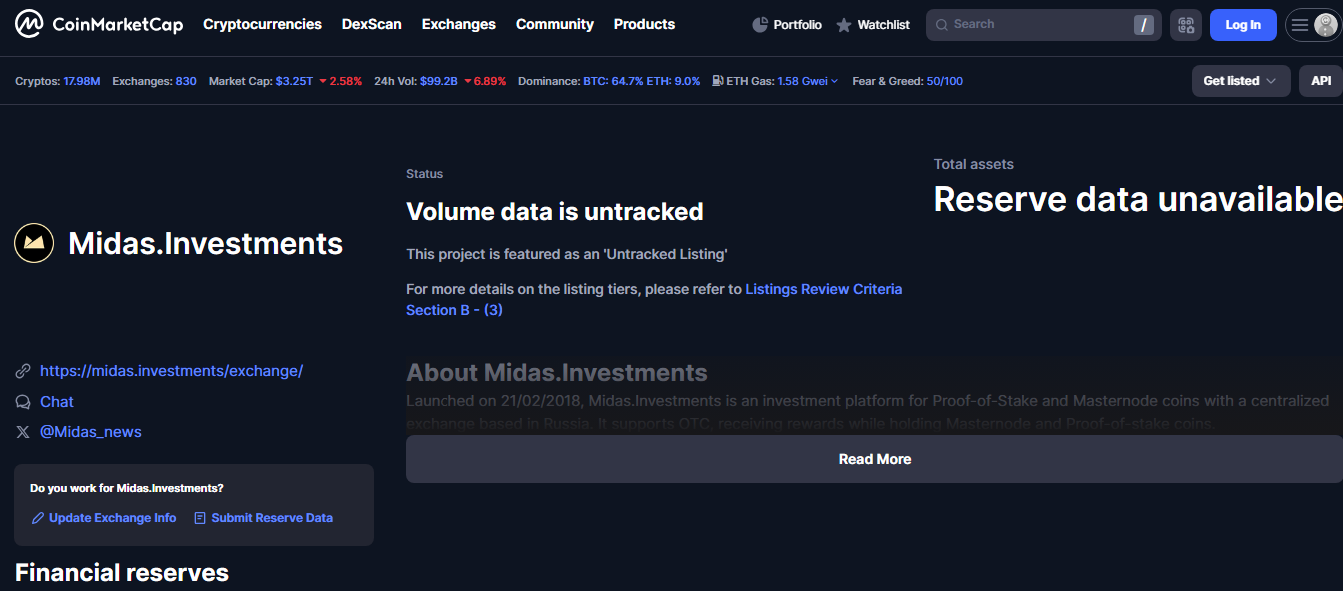Midas Investments Review – once a yield darling, now a hard lesson

Midas Investments began as a hybrid CeDeFi platform offering automated portfolio products, fixed yields on crypto deposits, and claim-backed risk management. It combined centralized management with DeFi protocols under the hood, letting users earn passive income without handling staking or liquidity pools directly. For a while, it drew thousands of investors chasing 10-20% stablecoin returns. Then it collapsed - revealing how easily trust can vanish in crypto when transparency is thin.
What Midas originally promised
The core pitch was simple. Deposit popular assets - BTC, ETH, USDC - and earn consistent yields, paid daily. Users could also pick automated vaults with algorithm-driven DeFi allocations. The platform handled farming, rebalancing, and technical nitty-gritty. You just sat back and watched your balance grow.
Key features they boasted included:
- Fixed yields often far above traditional markets. Even during bear dips, advertised APYs for stablecoins hovered around 10-12%, and BTC or ETH vaults reached higher.
- Passive DeFi strategies without the manual process. You didn’t need to learn staking mechanics or manage impermanent loss.
- Daily payouts directly into your wallet on the platform, creating a sense of reliable income flow.
- Portfolio rebalancing tools that promised to auto-optimize between stable assets and riskier growth tokens.
- In-house analytics that gave users insights into yield sources, though never with full on-chain audit clarity.
On paper, it was a hands-off dream for crypto holders wanting to do more than HODL.
Where it all unraveled
Starting in mid-2022, cracks began to show. Crypto contagion spread after major players like Celsius and Voyager imploded. Rumors swirled that Midas also had exposure to risky DeFi protocols and under-collateralized borrowers. By late 2022, the platform struggled with liquidity.
In December, the real blow landed: Midas Investments announced it was closing. Withdrawals were limited. Assets were effectively frozen as they wound down operations, citing a large deficit between liabilities and assets on hand. Users who thought they were in stable passive positions discovered they couldn’t fully access funds, or would receive them as restructured tokens with unclear real-world value.
Why the promise broke down
Several underlying weaknesses turned Midas from “easy income” into an example of why CeDeFi is so risky:
- No regulatory guarantees. Unlike a bank or licensed fund, Midas operated without strong external oversight. It could offer yields freely, but also halt operations at will.
- Opaque strategy. Marketing pages described high-level DeFi techniques, but offered no on-chain proofs or third-party verified breakdowns. You were trusting the team’s internal books - books you never saw.
- High offered yields. In bear markets, paying double-digit stablecoin returns usually means hidden risk. Midas’ payout model depended on constant new inflows and continued DeFi yield, both of which dried up as crypto prices fell.
- No formal insurance or reserves audits. So when market conditions changed, there was no capital buffer or insurance pot to cover holes.
Who it appealed to (before collapse)
Before shutting down, Midas drew:
- Retail investors chasing passive income. It was marketed as a simple alternative to staking on-chain or opening complex liquidity positions.
- Crypto newcomers. Many users didn’t want to learn MetaMask, bridges, or impermanent loss calculations. Midas let them avoid that by acting as a managed middleman.
- Busy holders. Even seasoned crypto users sometimes used Midas to put part of their stack on autopilot for “low effort” returns.
Who should now be wary
In hindsight, Midas stands as a textbook warning for:
- Anyone relying on centralized platforms without proof-of-reserves or strong licensing. Your assets exist at the mercy of internal management.
- Yield hunters ignoring underlying risks. Those stablecoin APYs were attractive, but ultimately unsustainable.
- Investors who prefer offloading research. Passive income requires due diligence on where your capital actually sits. Without it, surprises hit hard.
The harsh reality for users
Many account holders were left negotiating with the platform’s restructuring process, or trying to liquidate partial holdings in new illiquid tokens Midas issued. Stories circulated of withdrawals being delayed indefinitely or payouts arriving at a fraction of initial balances. Community channels turned from yield celebrations into groups sharing frustration and damage control tips.
Snapshot of strengths vs fatal flaws
Final take - lessons over returns
Midas Investments looked like a sophisticated gateway that merged CeFi convenience with DeFi profits. But as market stress revealed, it couldn’t keep promises under pressure. Without transparent, on-chain verified risk management or real regulatory protection, its house of cards fell.
Today, it serves as a reminder: if you can’t track your capital’s actual path, or if yields seem out of sync with safe returns, you’re effectively gambling on management’s honesty and market luck. In crypto, that’s rarely enough.
For investors looking for yield now, fully on-chain options with open smart contract audits, or regulated custodial platforms with clear insurance, are the safer alternatives. The story of Midas proves again: the higher the advertised ease and returns, the harder you must dig to understand the risks - or pay for them later.
Disclaimer
“This content is for informational purposes only and does not constitute financial advice. Please do your own research before investing.”
.png)







%203.svg)
%203.svg)




















